| Revision as of 17:19, 13 February 2008 view sourceClovisPt (talk | contribs)8,825 editsm →Subfamilies, genera and species← Previous edit | Revision as of 17:23, 13 February 2008 view source ClovisPt (talk | contribs)8,825 edits →Subfamilies, genera and speciesNext edit → | ||
| Line 119: | Line 119: | ||
| ****European ] (''Cervus elaphus'') | ****European ] (''Cervus elaphus'') | ||
| ****] (''Cervus wallichi'') | ****] (''Cervus wallichi'') | ||
| ****] (''Cervus canadensis'') ( |
****] (''Cervus canadensis'') (North American and Asian Elk; second largest deer in world; not to be confused with Moose, known as Elk in Europe) | ||
| ***Subgenus ''Przewalskium'': | ***Subgenus ''Przewalskium'': | ||
| ****], or ] (''Cervus albirostris'') | ****], or ] (''Cervus albirostris'') | ||
Revision as of 17:23, 13 February 2008
| Editing of this article by new or unregistered users is currently disabled due to vandalism. See the protection policy and protection log for more details. If you cannot edit this article and you wish to make a change, you can submit an edit request, discuss changes on the talk page, request unprotection, log in, or create an account. |
For other uses, see the ruminant animal.
| Deer Temporal range: Early Oligocene - Recent | |
|---|---|
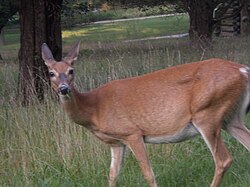
| |
| A white-tail deer | |
| Scientific classification | |
| Kingdom: | Animalia |
| Phylum: | Chordata |
| Class: | Mammalia |
| Order: | Artiodactyla |
| Suborder: | Ruminantia |
| Family: | Cervidae Goldfuss, 1820 |
| Subfamilies | |
|
Capreolinae/Odocoileinae | |
A deer is a ruminant mammal belonging to the family Cervidae. A number of broadly similar animals from related families within the order Artiodactyla (even-toed ungulates) are often also called deer. Male deer grow and shed new antlers each year, as opposed to antelope, which are in the same order and bear a superficial resemblance to deer physically, but are permanently horned.
Etymology
Depending on their species, male deer are called stags, harts, bucks or bulls, and females are called hinds, does or cows. Young deer are called fawns or calves. A group of deer is commonly called a herd. Hart, from Old English heorot ‘deer’, is a term for a stag, particularly a Red Deer stag past its fifth year. It is not commonly used, but Shakespeare makes several references, punning the sound alike "hart" and "heart" for example in Twelfth Night. "The White Hart" and "The Red Hart" are common English pub names, and the county Hertfordshire is named after them.
The history of the word deer was originally quite broad in meaning and came to be specialized. In Middle English, der (O.E. dēor) meant a beast or animal of any kind. This general sense gave way to the modern sense by the end of the Middle English period, around 1500. The German word Tier, the Dutch word dier and the Scandinavian words djur/dyr/dýr, cognates of English deer, still have the general sense of "animal." The adjective of relation pertaining to deer is cervine.
Habitat
Deer are widely distributed, and hunted, with indigenous representatives in all continents except Antarctica and Australia, though Africa has only one native species confined to the Atlas Mountains in the north-west of the continent, the Red Deer. (The Mouse Deer or Water Chevrotain of African forests is not a true deer; all other animals in Africa resembling deer are antelope).
Deer live in a variety of biomes ranging from tundra to the tropical rainforest. While often associated with forests, many deer are ecotone species that live in transitional areas between forests and thickets (for cover) and prairie and savanna (open space). The majority of large deer species inhabit temperate mixed deciduous forest, mountain mixed coniferous forest, tropical seasonal/dry forest, and savanna habitats around the world. Clearing open areas within forests to some extent may actually benefit deer populations by exposing the understory and allowing the types of grasses, weeds, and herbs to grow that deer like to eat. However, adequate forest or brush cover must still be provided for populations to grow and thrive.

Small species such as the brocket deer and pudus of Central and South America, and the muntjacs of Asia occupy dense forests and are less often seen in open spaces. There are also several species of deer that are highly specialized, and live almost exclusively in mountains, grasslands, swamps and "wet" savannas, or riparian corridors surrounded by deserts. Some deer have a circumpolar distribution in both North America and Eurasia. Examples include the reindeer (caribou) that live in Arctic tundra and taiga (boreal forests) and moose that inhabit taiga and adjacent areas.
The highest concentration of large deer species in temperate North America lies in the Canadian Rocky Mountain and Columbia Mountain Regions between Alberta and British Columbia where all five North American deer species (White-tailed Deer, Mule deer, Caribou, Elk, and Moose) can be found. This is a region that boasts mountain slopes with diverse types of coniferous and mixed forested areas along with lush alpine meadows. The foothills and river valleys between the mountain ranges provide a mosaic of cropland and deciduous parklands. The aspen parklands north of Calgary also have many lakes and marshes. Elk and Mule Deer are probably the most common animals throughout the region. The caribou live at higher altitudes in the subalpine meadows and alpine tundra areas. The White-tailed Deer have recently expanded their range within the foothills and river valleys of the Canadian Rockies due to conversion of land to cropland and the clearing of coniferous forests allowing more deciduous vegetation to grow. They often share this riparian habitat with moose, but left the adjacent Great Plains and drier grassland habitats to Elk, American bison, and pronghorn antelope.

The highest concentration of large deer species in temperate Asia occurs in the mixed deciduous forests, mountain coniferous forests, and taiga bordering North Korea, Manchuria (Northeastern China), and the Ussuri Region (Russia). These are among some of the richest deciduous and coniferous forests in the world where one can find Siberian Roe Deer, Sika Deer, Caribou, Elk, and Moose. Just south of this region in China, one can find the unusual Pere David's Deer. Deer such as the Sika Deer, Thorold's Deer, Central Asian Red Deer, and Elk have historically been farmed for their antlers by Han Chinese, Turkic peoples, Tungusic peoples, Mongolians, and Koreans. Like the Sami people of Finland and Scandinavia, the Tungusic peoples, Mongolians, and Turkic peoples of Southern Siberia, Northern Mongolia, and the Ussuri Region have also taken to raising semi-domesticated herds of caribou.
The highest concentration of large deer species in the tropics occurs in Southern Asia and Southeast Asia in the Countries of India, Nepal, and at one time, Thailand. Northern India's Indo-Gangetic Plain Region and Nepal's Terai Region consist of tropical seasonal moist deciduous, dry deciduous forests, and both dry and wet savannas that are home to Chital, Hog Deer, Barasingha, Indian Sambar, and Indian Muntjac. Just slightly north of the Indo-Gangetic Plain is the Vale of Kashmir, home to the rare Kashmir Stag, a subspecies of Central Asian Red Deer. The Chao Praya River Valley of Thailand was once primarily tropical seasonal moist deciduous forest and wet savanna that hosted populations of Hog Deer, Schomburgk's Deer (now extinct), Eld's Deer, Indian Sambar, and Indian Muntjac. Today, both the Barasingha and Eld's Deer are endangered or rare. The hog deer populations in Thailand are also rare. Chital and Barasingha live in large herds, and Indian sambar may also be found in large groups. Of all these deer species, hog deer are solitary and have the lowest deer densities. How all these deer can co-exist in one area is due to the fact that they prefer different types of vegetation for food. These deer also share their habitat with various herbivores such as Asian elephants, various antelope species (i,e, ... such as nilgai, four-horned antelope, blackbuck, and Indian gazelle in India), and wild oxen (i.e., ... such as gaur, banteng, and kouprey). Incidentally, the European deciduous forests and North American deciduous forests (west of the Appalachian Mountains) were historically also shared by both deer species and wild oxen. The mixed deciduous forests and prairies of Europe were once home to European Red Deer, European Roe Deer, Moose, aurochs (forest ox), and wisent (European bison). The mixed deciduous forests and prairies of North America's midwest were once home to white-tailed deer and large herds of Elk and American Bison. Today most of these forest and prairie lands have become converted to cropland. Much of the forest and prairie land west of North America's Appalachian Mountains is part of United States' Midwest Agricultural Region and primarily supports white-tailed deer. The Elk and American bison herds have recently (the past century) become extinct in these areas with elk and bison reintroduced to some areas. The forests of Europe are also mostly cropland and European Red Deer and European Roe Deer survive only in protected areas. The aurochs are an extinct, but are believed to be the ancestors of today's domestic cattle. The wisent almost became extinct, but have survived in captivity and have been reintroduced to some forest reserves in Europe.
Australia has six introduced species of deer that have established sustainable wild populations from Acclimatisation Society releases in the 19th Century. These are Fallow Deer, Red Deer, Sambar Deer, Hog Deer, Rusa deer, and Chital Deer. Red Deer introduced into New Zealand in 1851 from English and Scottish stock were domesticated in deer farms by the late 1960s and are common farm animals there now. Seven other species of deer were introduced into New Zealand but none are as widespread as Red Deer.
Biology
Deer generally have lithe, compact bodies and long, powerful legs suited for rugged woodland terrain. Deer are also excellent swimmers. Deer are ruminants, or cud-chewers, and have a four-chambered stomach. The teeth of deer are adapted to feeding on vegetation, and like other ruminants, they lack upper incisors, instead having a tough pad at the front of their upper jaw. The Chinese water deer and Tufted deer have enlarged upper canine teeth forming sharp tusks, while other species often lack upper canines altogether. The cheek teeth of deer have crescent ridges of enamel, which enable them to grind a wide variety of vegetation. The dental formula for deer is:
| Dentition |
|---|
| 0.0-1.3.3 |
| 3.1.3.3 |
Nearly all deer have a facial gland in front of each eye. The gland contains a strongly scented pheromone, used to mark its home range. Bucks of a wide range of species open these glands wide when angry or excited. All deer have a liver without a gallbladder. Deer also have a Tapetum lucidum which gives them sufficiently good night vision.
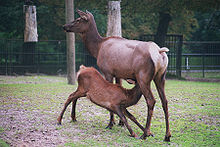
A doe generally has one or two fawns at a time (triplets, while not unknown, are uncommon). The gestation period is anywhere up to ten months for the European roe deer. Most fawns are born with their fur covered with white spots, though they lose their spots once they get older (excluding the Fallow Deer who keeps its spots for life). In the first twenty minutes of a fawn's life, the fawn begins to take its first steps. Its mother licks it clean until it is almost free of scent, so predators will not find it. Its mother leaves often, and the fawn does not like to be left behind. Sometimes its mother must gently push it down with her foot. The fawn stays hidden in the grass for one week until it is strong enough to walk with its mother. The fawn and its mother stay together for about one year. A male usually never sees his mother again, but females sometimes come back with their own fawns and form small herds.

Deer are selective feeders. They are usually browsers, and primarily feed on leaves. They have small, unspecialized stomachs by ruminant standards, and high nutrition requirements. Rather than attempt to digest vast quantities of low-grade, fibrous food as, for example, sheep and cattle do, deer select easily digestible shoots, young leaves, fresh grasses, soft twigs, fruit, fungi, and lichens.
Antlers
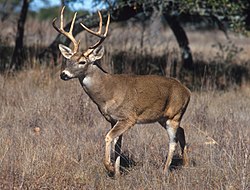
With the exception of the Chinese water deer, all male deer have antlers that are shed and regrown each year from a structure called a pedicle. Sometimes a female will have a small stub. The only female deer with antlers are Reindeer (Caribou). Antlers grow as highly vascular spongy tissue covered in a skin called velvet. Before the beginning of a species' mating season,
The one way that many hunters are able to track main paths that the deer travel on is because of their "rubs". A rub is used to deposit scent from glands near the eye and forehead and physically mark territory.
During the mating season, bucks use their antlers to fight one another for the opportunity to attract mates in a given herd. The two bucks circle each other, bend back their legs, lower their heads, and charge.
Each species has its own characteristic antler structure, e.g. each white-tailed deer antler includes a series of tines sprouting upward from a forward-curving main beam. Mule deer (and black-tailed deer), species within the same genus as the white-tailed deer, instead have bifurcated (or branched) antlers -- that is, the main beam splits into two, each of which may split into two more.
For Wapiti and Red Deer, a stag having 14 points is an "imperial", and a stag having 12 points is a "royal". If the antlers deviate from the species' normal antler structure, the deer is considered a non-typical deer.
Evolution
The earliest fossil deer date from the Oligocene of Europe, and resembled the modern muntjacs. Later species were often larger, with more impressive antlers, and, in many cases, lost of the upper canine teeth. They rapidly spread to the other continents, even for a time occupying much of northern Africa, where they are now almost wholly absent. Some extinct deer had huge antlers, larger than those of any living species. Examples include Eucladoceros, and the giant deer Megaloceros, whose antlers stretched to 3.5 metres across.
Economic significance

Deer have long had economic significance to humans. Deer meat, for which they are hunted and farmed, is called venison. Deer organ meat is called umble. See humble pie.
Musk, which comes from the gland on the abdomen of musk deer, is used in medicines and perfumes. Deerskin is used for shoes, boots, and gloves, and antlers are made into buttons and knife handles.
The Saami of Scandinavia and the Kola Peninsula of Russia and other nomadic peoples of northern Asia used reindeer for food, clothing, and transport.
The caribou is not domesticated or herded as is the case in Europe but is important to the Inuit. Most commercial venison in the United States is imported from New Zealand.

Deer were originally brought to New Zealand by European settlers, and the deer population rose rapidly. This caused great environmental damage and was controlled by hunting and poisoning until the concept of deer farming developed in the 1960s. Deer farms in New Zealand number more than 3,500, with more than 400,000 deer in all.
Automobile collisions with deer impose a significant cost on the economy. In the U.S., about 1.5 million deer-vehicle collisions occur each year, according to the National Highway Traffic Safety Administration. Those accidents cause about 150 deaths and $1.1 billion in property damage annually.
Taxonomy
Note that the terms indicate the origin of the groups, not their modern distribution: the water deer, for example, is a New World species but is found only in China and Korea.
It is thought that the new world group evolved about 5 million years ago in the forests of North America and Siberia, the old world deer in Asia.
Subfamilies, genera and species
The family Cervidae is organized as follows:
- Subfamily Muntiacinae (Muntjacs)
- Genus Muntiacus:
- Indian muntjac or Common Muntjac (Muntiacus muntjak)
- Reeves's muntjac or Chinese Muntjac (Muntiacus reevesi)
- Hairy-fronted muntjac or Black Muntjac (Muntiacus crinifrons)
- Fea's muntjac (Muntiacus feae)
- Bornean Yellow muntjac (Muntiacus atherodes)
- Roosevelt's muntjac (Muntiacus rooseveltorum)
- Gongshan muntjac (Muntiacus gongshanensis)
- Giant muntjac (Muntiacus vuquangensis)
- Truong Son muntjac (Muntiacus truongsonensis)
- Leaf muntjac (Muntiacus putaoensis)
- Genus Elaphodus:
- Tufted deer (Elaphodus cephalophus)
- Genus Muntiacus:
- Subfamily Cervinae (True Deer, Old World Deer):
- Genus Cervus:
- Subgenus Cervus:
- European red deer (Cervus elaphus)
- Central Asian Red Deer (Cervus wallichi)
- Elk (Cervus canadensis) (North American and Asian Elk; second largest deer in world; not to be confused with Moose, known as Elk in Europe)
- Subgenus Przewalskium:
- Thorold's deer, or white-lipped deer (Cervus albirostris)
- Subgenus Sika:
- Sika Deer (Cervus nippon)
- Subgenus Rucervus:
- Barasingha (Cervus duvaucelii)
- Schomburgk's Deer (Cervus schomburgki) (extinct, 1938)
- Eld's Deer or Thamin (Cervus eldii)
- Subgenus Rusa:
- Indian Sambar (Cervus unicolor)
- Sunda Sambar or Rusa Deer (Cervus timorensis)
- Philippine Sambar (Cervus mariannus)
- Philippine Spotted Deer or Visayan Spotted Deer (Cervus alfredi) (smallest Old World deer)
- Subgenus Cervus:
- Genus Axis:
- Subgenus Axis:
- Subgenus Hyelaphus:
- Hog deer (Axis porcinus)
- Calamian deer (Axis calamianensis)
- Bawean deer (Axis kuhlii)
- Genus Elaphurus:
- Père David's Deer (Elaphurus davidianus)
- Genus Dama:
- Fallow deer (Dama dama)
- Persian fallow deer (Dama mesopotamica)
- Giant Deer (Megaloceros giganteus) †
- Genus Cervus:

- Subfamily Hydropotinae (Water Deer)
- Genus Hydropotes:
- Chinese water deer (Hydropotes inermis)
- Genus Hydropotes:
- Subfamily Odocoileinae/Capreolinae (New World Deer)
- Genus Odocoileus:
- White-tailed deer (Odocoileus virginianus)
- Mule deer, or Black-tailed deer (Odocoileus hemionus)
- Genus Blastocerus:
- Marsh deer (Blastocerus dichotomus)
- Genus Ozotoceros:
- Pampas deer (Ozotoceros bezoarticus)
- Genus Mazama:
- Red Brocket (Mazama americana)
- Merioa Brocket (Mazama bricenii)
- Dwarf Brocket (Mazama chunyi)
- Grey Brocket (Mazama gouazoubira)
- Pygmy Brocket (Mazama nana)
- Yucatan Brown Brocket (Mazama pandora)
- Little Red Brocket (Mazama rufina)
- Genus Pudu:
- Northern Pudú (Pudu mephistophiles) (smallest deer in the world)
- Southern Pudú (Pudu pudu)
- Genus Hippocamelus:
- Taruca or North Andean Deer (Hippocamelus antisensis)
- Chilean Huemul or South Andean Deer (Hippocamelus bisulcus)
- Genus Capreolus:
- European Roe Deer (Capreolus capreolus)
- Siberian Roe Deer (Capreolus pygargus)
- Genus Rangifer:
- Caribou/Reindeer (Rangifer tarandus)
- Genus Alces:
- Moose (Alces alces; called "Elk" in England and Scandinavia) (largest deer in the world)
- Genus Odocoileus:
Hybrid deer
In Origin of Species (1859) Charles Darwin wrote "Although I do not know of any thoroughly well-authenticated cases of perfectly fertile hybrid animals, I have some reason to believe that the hybrids from Cervulus vaginalis and Reevesii are perfectly fertile." These two varieties of muntjac are currently considered the same species.
A number of deer hybrids are bred to improve meat yield in farmed deer. American Elk (or Wapiti) and Red Deer from the Old World can produce fertile offspring in captivity, and were once considered one species. Hybrid offspring, however, must be able to escape and defend themselves against predators, and these hybrid offspring are unable to do so in the wild state. Recent DNA, animal behavior studies, and morphology and antler characteristics have shown there are not one but three species of Red Deer: European Red Deer, Central Asian Red Deer, and American Elk or Wapiti. (The European Elk is a different species and is known as moose in North America.) The hybrids are about 30% more efficient in producing antler by comparing velvet to body weight. Wapiti have been introduced into some European Red Deer herds to improve the Red Deer type, but not always with the intended improvement.
In New Zealand, where deer are introduced species, there are hybrid zones between Red Deer and North American Wapiti populations and also between Red Deer and Sika Deer populations. In New Zealand Red Deer have been artificially hybridized with Pere David Deer in order to create a farmed deer which gives birth in spring. The initial hybrids were created by artificial insemination and back-crossed to Red Deer. However, such hybrid offspring can only survive in captivity free of predators.
In Canada, the farming of European Red Deer and Red Deer hybrids is considered a threat to native Wapiti. In Britain, the introduced Sika Deer is considered a threat to native Red Deer. Initial Sika Deer/Red Deer hybrids occur when young Sika stags expand their range into established red deer areas and have no Sika hinds to mate with. They mate instead with young Red hinds and produce fertile hybrids. These hybrids mate with either Sika or Red Deer (depending which species is prevalent in the area), resulting in mongrelization. Many of the Sika Deer which escaped from British parks were probably already hybrids for this reason. These hybrids do not properly inherit survival strategies and can only survive in either a captive state or when there are no predators.
In captivity, Mule Deer have been mated to White-tail Deer. Both male Mule Deer/female White-tailed Deer and male White-tailed Deer/female Mule Deer matings have produced hybrids. Less than 50% of the hybrid fawns survived their first few months. Hybrids have been reported in the wild but are disadvantaged because they don't properly inherit survival strategies. Mule Deer move with bounding leaps (all 4 hooves hit the ground at once, also called "stotting") to escape predators. Stotting is so specialized that only 100% genetically pure Mule Deer seem able to do it. In captive hybrids, even a one-eighth White-tail/seven-eighths Mule Deer hybrid has an erratic escape behaviour and would be unlikely to survive to breeding age. Hybrids do survive on game ranches where both species are kept and where predators are controlled by man.
Impact on popular culture
Heraldry
Deer are represented in heraldry by the stag or hart (or less often by the hind). Stag's heads and antlers also appear as charges.
Examples can be found in the arms of Hertfordshire and its county town of Hertford, both examples of canting arms (a heraldic pun).
Several Norwegian municipalities have a stag or stag's head in their arms: Gjemnes, Hitra, Hjartdal and Voss.
A deer appears on the arms of the Israeli Postal Authority (see Hebrew Misplaced Pages page )
-
Arms of Hertfordshire, England
Arms of Hertfordshire, England -

Arms of Raon aux Bois, France -
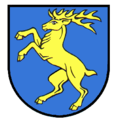
Arms of Dotternhausen, Germany -

Arms of Thierachern, Switzerland -

Arms of Friolzheim, Germany -

Arms of Bauen, Switzerland -
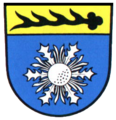
Arms of Albstadt, Germany -

Arms of the Earls Bathurst -
Arms of Gjemnes, Norway
Arms of Gjemnes, Norway -
Arms of Hitra, Norway
Arms of Hitra, Norway -
Arms of Hjartdal, Norway
Arms of Hjartdal, Norway -
Arms of Voss, Norway
Arms of Voss, Norway -
 Logo of the Jerusalem Biblical Zoo
Logo of the Jerusalem Biblical Zoo
Literature and art
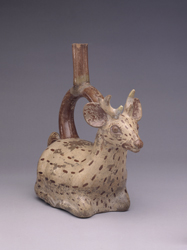

- For the role of deer in mythology, see deer in mythology.
- The "Golden Hind" was an English galleon best known for its global circumnavigation between 1577 and 1580, captained by Sir Francis Drake.
- The book Fire Bringer is a fiction book that is about a young fawn who is born and goes on a quest to save the deer kind who are called the Herla in the novel.
- In Christmas lore (such as in the narrative poem "A Visit from St. Nicholas"), reindeer are often depicted pulling the sleigh of Santa Claus.
- One famous fictional deer is Bambi. In the Disney film Bambi, he is a white-tailed deer, while in Felix Salten's original book Bambi, A Life in the Woods, he is a roe deer.
- The Pulitzer Prize-winning 1938 novel The Yearling, written by Marjorie Kinnan Rawlings, was about a boy's relationship with a baby deer, later adapted to a children's film that was nominated for an Academy Award for Best Picture.
- Saint Hubertus saw a stag with a crucifix between its antlers while hunting on Good Friday and was converted to Christianity by the vision.
- In the Harry Potter series, the Patronus Charm that Harry Potter conjures to repel Dementors is a silver stag. James Potter, Harry's father, had an Animagus form as a stag. Also, Harry's mother Lily, and subsequently Severus Snape's, Patronus form was a doe.
- In one of the stories of Baron Munchhausen, the baron encounters a stag while eating cherries and without ammunition, fires the cherry-pits at the stag with his musket, but it escapes. The next year, the baron encounters a stag with a cherry tree growing from its head; presumably this is the animal he had shot at the previous year.
- A Samurai warrior named Honda Tadakatsu famously adorned deer antlers on his helmet.
- Deer have been a subject in Chinese paintings numerous times as a tranquility symbol.
- In The Animals of Farthing Wood, a deer called The Great White Stag is the leader of all the animal residents of the nature reserve White Deer Park.
- In The Queen, a 14 point "Imperial" stag plays a role in the film.
- Deer are depicted in many materials by various pre-Hispanic civilizations in the Andes.
- Several German towns are called "Hirschberg", a name composed of Hirsch (deer) and Berg (hill or mountain).
- Among East European Jews, "Hirsh" - Yiddish for "stag" - was a common male name, and was among other others the name of several prominent Rabbis; in this community there was, however, no equivalent female name. In contemporary Israel, several Hebrew names for this animal are commonly used as both male and female names. These include "Tzvi" (צבי) and "Eyal"(אייל) - two synonymous words for "stag"; "Tzviya" (צביה) and "Ayala" (איילה) - the respective parallel words for "Hind" or "Doe"; as well as "Ofer" (עופר) and "Ofra"(עפרה), respectively the male and female words for the young of this animal - which are all commonly used as first names among the Israeli population. In addition, there are Israelis having as their first name "Bambi", derived from the well-known Disney animated film.
See also
References
- Deer An Encyclopaedia of New Zealand 1966
- Cockerill, Rosemary (1984). Macdonald, D. (ed.). The Encyclopedia of Mammals. New York: Facts on File. pp. 520–529. ISBN 0-87196-871-1.
- The phylogenetic position of the 'giant deer' Megaloceros giganteus. Letter in Nature 438, 850-853 (8 December 2005)
- Berrin, Katherine & Larco Museum. The Spirit of Ancient Peru:Treasures from the Museo Arqueológico Rafael Larco Herrera. New York: Thames and Hudson, 1997.
| This article needs additional citations for verification. Please help improve this article by adding citations to reliable sources. Unsourced material may be challenged and removed. Find sources: "Deer" – news · newspapers · books · scholar · JSTOR (August 2007) (Learn how and when to remove this message) |
External links
- Family Cervidae at the Animal Diversity Web
- Chronic Wasting Disease Information
- The World Deer Group
- Deer's life
- Deer in the Yard
| Heraldry | |||||||||||||||
|---|---|---|---|---|---|---|---|---|---|---|---|---|---|---|---|
| Types | |||||||||||||||
| Topics | |||||||||||||||
| Achievement | |||||||||||||||
| Charges |
| ||||||||||||||
| Tinctures |
| ||||||||||||||
| Applications | |||||||||||||||
| Related | |||||||||||||||
| |||||||||||||||